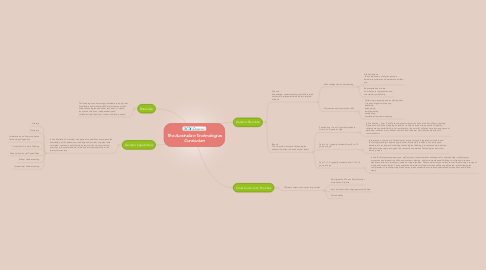
1. Rationale
1.1. This learning area encourages students to apply their knowledge and practical skills and processes when using technologies and other resources to create innovative solutions, independently and collaboratively, that meet current and future needs.
2. General Capabilities
2.1. In the Australian Curriculum, the general capabilities encompass the knowledge, skills, behaviours and dispositions that, together with curriculum content in each learning area and the cross-curriculum priorities, will assist students to live and work successfully in the twenty-first century
2.1.1. Literacy
2.1.2. Numeracy
2.1.3. Information and Communication Technology Capability
2.1.4. Critical and Creative Thinking
2.1.5. Personal and Social Capabilities
2.1.6. Ethical Understanding
2.1.7. Intercultural Understanding
3. Content Structure
3.1. Strands Knowledge, understanding and skills in each subject are presented through two related strands
3.1.1. •Knowledge and understanding
3.1.1.1. Digital systems the components of digital systems: hardware, software and networks and their use
3.1.1.2. Representation of data how data are represented and structured symbolically
3.1.2. •Processes and production skills
3.1.2.1. Collecting, managing and analysing data Creating digital solutions by: •defining •designing •implementing •evaluating •collaborating and managing
3.2. Bands The curriculum for each Technologies subject is written in bands of year levels
3.2.1. Foundation – Year 2: typically students from 5 to 8 years of age
3.2.1.1. In Foundation – Year 2, the Technologies curriculum builds on the Early Years Learning Framework and its key learning outcomes: children have a strong sense of identity; children are connected with, and contribute to, their world; children have a strong sense of wellbeing; children are confident and involved learners; and children are effective communicators.
3.2.2. Year 3 – 6: typically students from 8 to 12 years of age
3.2.2.1. In these years, learning in Technologies occurs through integrated curriculum and Technologies subject-specific approaches. Students’ activities in the early years develop into an interest in learning technologies thinking, processes and production. Students increasingly recognise the connections between Technologies and other learning areas
3.2.3. Year 7 – 10: typically students from 12 to 16 years of age
3.2.3.1. In the Technologies learning area, students use technologies knowledge and understanding; technologies processes and production skills; and systems, design, and/or computational thinking to solve and produce creative solutions to problems, needs or opportunities. They communicate and record their ideas using a range of media and technologies. These specialised problem-solving activities will be sophisticated, acknowledge the complexities of contemporary life and may make connections to related specialised occupations and further study
4. Cross Curriculum Priorities
4.1. There are three cross-curricular priorities
4.1.1. Aboriginal and Torres Strait Islander histories and culture
4.1.2. Asia and Australia's engagement with Asia
4.1.3. Sustainability
